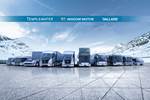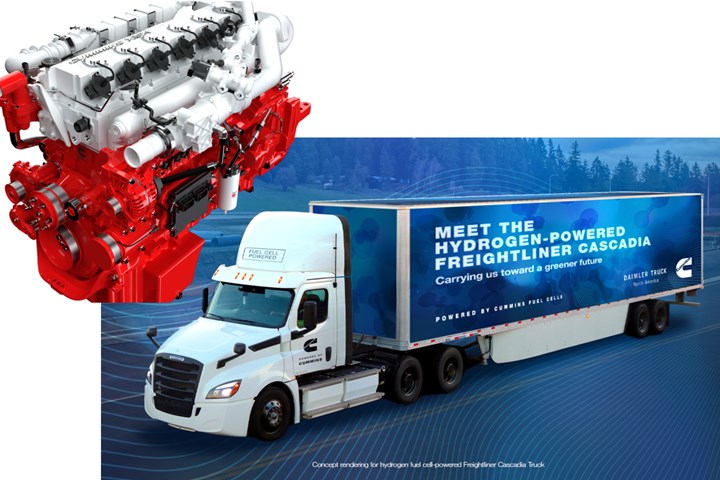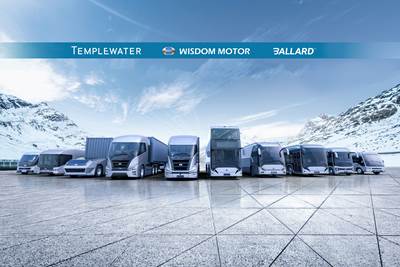Cummins debuts 15-liter hydrogen engine and partners with Daimler for fuel cell trucks
Full-scale production of H2 ICE expected in 2027 while Daimler Truck will have initial fuel cell trucks available to select North American customers in 2024.
Cummins Inc. (Columbus, Ind., U.S.) has debuted its 15-liter hydrogen (H2) combustion engine at the ACT Expo in Long Beach, Calif. This engine is built on Cummins’ new fuel-agnostic platform — below the head gasket, each engine has largely similar components, while above the head gasket, each has different components for different fuel types. This engine, used with clean, zero-carbon H2 as a fuel, is a key enabler of Cummins’ strategy to go further faster to help customers reduce greenhouse gas (GHG) emissions. Full production is expected in 2027.
Cummins has also announced it will collaborate with Daimler Truck North America (DTNA, Portland, Ore., U.S.), reportedly the largest heavy-duty truck manufacturer in North America, to upfit and validate Freightliner Cascadia trucks with a Cummins H2 fuel cell powertrain for use in North America. First units are slated to be available in 2024.
Cummins H2 combustion engines
Cummins announced the testing of hydrogen internal combustion engine (ICE) technology in July 2021. It reports that it has made impressive early results, already achieving targets for production power (290 horsepower) and torque (>810 foot-pounds) from the medium-duty engine. Additional testing on Cummins’ more advanced prototypes will begin soon, and the company can quickly scale production with its significant global manufacturing footprint.
Cummins’ vision is that the industry needs multiple solutions to meet the needs of all on- and off-highway customers and all applications considering the variety of duty cycles and operating environments. This new H2 combustion engine will be a zero-carbon solution for multiple markets. Cummins intends to produce H2 internal combustion engines in both 15-liter and 6.7-liter displacements, believing that these engines enable the industry to take action and reduce GHG emissions this decade, ultimately accelerating CO2 reduction.
“We’ve established significant goals as part of our PLANET 2050 sustainability strategy, including a target of zero emissions,” Srikanth Padmanabhan, president of Engine Business, Cummins Inc., says. “Reducing well-to-wheels carbon emissions requires innovation of both energy sources and power solutions. While use cases for battery electric and fuel cell electric powertrains are promising, the pairing of green hydrogen in the proven technology of internal combustion engines provides an important complement to future zero emissions solutions.”
“Working with Cummins to navigate the journey to zero emissions means working with an experienced partner that has the right knowledge, tools and resources to ensure a smooth transition,” Jim Nebergall, general manager, Hydrogen Engines at Cummins Inc., adds. “Our customers are responding favorably to this practical technology. These engines look like engines, they sound like engines and fit where engines normally fit.”
Cummins claims that H2 ICE use zero-carbon fuel at a lower initial price versus a fuel cell or battery electric vehicle (BEV) with little modification to today’s vehicles. It also posits that accelerated market adoption of H2 engine vehicles will be driven by the technology’s high maturity, low initial cost, extended vehicle range, fast fueling, powertrain installation commonality and end-user familiarity.
“Heavy-duty trucking is critical to the global economy and is one of the hard-to-abate sectors of the economy,” Daryl Wilson, executive director of the Hydrogen Council, says. “We are encouraged by progress at Cummins in the development of hydrogen-fueled internal combustion engines and look forward to continued advancements that can help us reach cost-effective decarbonization of economies worldwide.”
Cummins and Daimler to deliver fuel cell trucks in North America
In addition to the company’s development of H2 ICE, Cummins is also pursuing H2 fuel cell applications. DTNA is collaborating with Cummins to validate Freightliner Cascadia trucks with a Cummins H2 fuel cell powertrain for use in North America. Freightliner will leverage Cummins’ fourth generation fuel cell powertrain, which provides improved power density, efficiency and durability.
The joint effort will support both organizations’ goals to reduce emissions across product offerings and operations. Upon successful validation, the companies intend to have initial units available in 2024 for selected customers.
“Cummins and Daimler Truck have a strong history of partnership, and this next step into fuel cell electric vehicles [FCEVs] is an exciting development for zero-emissions transport,” Amy Davis, president of New Power at Cummins, says. “Hydrogen fuel cells are a promising solution for the demanding requirements of heavy-duty trucking. Our collaboration in this market is an important milestone for both companies as we work to accelerate the shift to a carbon-free economy.”
“CO2-neutral commercial transportation must not only be technically feasible, but also economically viable for our valued customers,” Rakesh Aneja, vice president and chief of eMobility at DTNA, notes. “Depending on the customer application and energy infrastructure considerations, hydrogen-powered vehicles can absolutely complement battery-powered electric vehicles in accelerating our carbon-neutral journey. We are pleased to expand our partnership with Cummins to include hydrogen-powered fuel cell electric vehicles in our future portfolio. We remain focused on serving our customers by providing them with a choice of propulsion-technologies, ultimately resulting in solutions that best suit their business needs.”
Related Content
Achieving composites innovation through collaboration
Stephen Heinz, vice president of R&I for Syensqo delivered an inspirational keynote at SAMPE 2024, highlighting the significant role of composite materials in emerging technologies and encouraging broader collaboration within the manufacturing community.
Read MoreHexagon Purus opens new U.S. facility to manufacture composite hydrogen tanks
CW attends the opening of Westminster, Maryland, site and shares the company’s history, vision and leading role in H2 storage systems.
Read MoreComposites end markets: Energy (2024)
Composites are used widely in oil/gas, wind and other renewable energy applications. Despite market challenges, growth potential and innovation for composites continue.
Read MoreRecycling end-of-life composite parts: New methods, markets
From infrastructure solutions to consumer products, Polish recycler Anmet and Netherlands-based researchers are developing new methods for repurposing wind turbine blades and other composite parts.
Read MoreRead Next
Ballard Power and Wisdom Motor Co. partner to accelerate adoption of fuel cell commercial vehicles
As part of the collaboration, the companies plan to introduce and demonstrate a double-decker fuel cell bus in Hong Kong this year.
Read MoreVIDEO: High-volume processing for fiberglass components
Cannon Ergos, a company specializing in high-ton presses and equipment for composites fabrication and plastics processing, displayed automotive and industrial components at CAMX 2024.
Read More“Structured air” TPS safeguards composite structures
Powered by an 85% air/15% pure polyimide aerogel, Blueshift’s novel material system protects structures during transient thermal events from -200°C to beyond 2400°C for rockets, battery boxes and more.
Read More


















.jpg;maxWidth=300;quality=90)








